The two most difficult things about having a CSA are the lack of control over what you get, and the use it or lose it nature of produce. We have our biggest problem with winter storage vegetables, as they slowly pile up in our fridge and basement.
When we recently had a bag of potatoes that we hadn’t used, we made a very nice curry out of it. Last night we were staring at a bunch of unused parsnips (about 10!), so we figured, why not see if the same trick will work twice? Instead of potato-peanut curry we made a parsnip-cashew curry. Great success!
I often find curries to be intimidating because it always seems like they have 1,000 ingredients. In reality, they’re actually pretty simple to make, once you figure out how best to wrangle the ingredient list. Recipes often require the same ingredient in two places but only list it once in the ingredient list, which drives me mad. In an effort to make things easier I’ve deconstructed the timing of this recipe and put each ingredient into a group according to the timing (I had to toss our usual “where we got it” column to make room).
A lot of the work can be done a day or two in advance (making it a good Monday or Tuesday night dinner). Anything that includes an asterisk in the “Timing” column can be prepped or at least measured out in advance.
Parsnip-Cashew Curry Serves 4
| Timing | Amount | Ingredient | Preparation | In Advance * | 1 cup | Dried chickpeas or beans | Soaked in cold water overnight, then drained. We used soldier beans.0 |
|---|---|---|---|
| The Cashews * | 0.5 cups | Cashews | Toasted and ground/td> |
| The Paste * | 5 | Cloves | Garlic |
| The Paste * | 1 | Small onion | Or 1/2 of a larger one |
| The Paste * | 2 inch piece | Raw ginger | We keep ours frozen an then grate it with a microplane |
| The Paste * | 2 | Fresh green chilis, or about 8 dried | Finely chopped (fresh) or crumbled (dried); set half aside |
| The Paste * | 5 TBsp | Water | |
| Initial spices * | 1 tsp | Cumin seeds | |
| Initial spices * | 2 tsp | Ground corriander | |
| Initial spices * | 1 tsp | Tumeric | |
| Initial spices * | 1 tso | Chili powder | |
| Main Ingredients | 2 lbs | Parsnips | Cut into half-inch chunks, woody inner core cut out if you like |
| Main Ingredients | 9 oz | Tomatoes | Peeled and chopped. We used the ones we canned last September |
| Main Ingredients | 4 TBsp | Sunflower oil | Can use canola or another oil (although olive oil might add too much flavor) |
| Main Ingredients | 0.75 pint | Water | Just shy of 2 cups, if that’s easier |
| Finishing Ingredients | 1 tsp | Ground cumin | Either toast and grind whole seeds (since you are using whole seeds already) or use pre-ground |
| Finishing Ingredients | 2 cloves | Garlic | Minced |
| Finishing Ingredients | Lime juice | Juice of 1 lime, or a few TBsp of bottles juice | |
| Finishing Ingredients | To taste | Kosher salt | |
| Finishing Ingredients | To taste | Black pepper | Freshly ground |
| Finishing Ingredients | 1 handful | Cashews | Toasted |
| Finishing Ingredients | As desired | Plain yogurt | We used our own homemade yogurt |
| Finishing Ingredients | A handful | Fresh cilantro leaves or parsley | To garnish |
Directions
- Soak the chickpeas or beans overnight in cold water.
- Drain the chickpeas / beans. Place them in a pot and add enough cold water to cover them. Bring it to a boil and let it boil vigorously for 10 minutes. Lower the heat to a low boil and cook for 60 – 90 minutes or until the beans are tender. Drain and set aside. This can be done a number of days in advance.
We usually opt for cooking a larger amount of beans in a crock pot on low for 6 hours, which we’ll use over the course of a week or two. That saves us a lot of time and effort on this step, including not having to keep an eye on a boiling pot.
- Set the oven to 400 degrees. Measure out 0.5 cup of raw cashews plus one extra handful, and toast for 5-10 minutes (you can tell by the aroma when they are done). Set aside the handful for garnish. Put the rest into the food processor and pulse until they are finely ground. This can all be done well in advance.
- The next step is to make the garlic-ginger paste. If you have a powerful enough food processor, you can just throw everything from “The Paste” together without pre-chopping. If your food processor is closer to our old model, you may want to pre-chop the ingredients into smaller pieces. Don’t worry if you have some cashew dust residue from the prior step; no need to clean now. Because we keep our ginger frozen, we took out a frozen two-inch piece and grated it directly into the work bowl of the food processor using a microplane.
If you are using fresh chilis and wish to limit the hear, you should cut them open, remove the seeds with a spoon, and chop them up first. If you are using dried chilis (like we did) and want to limit the heat, you will want to crumble the chilis into a work bowl and them fish out the flesh, leaving some (or all) of the seeds behind). Only use half of the chilis at this point and set the rest aside for later.
Add all the ingredients for “The Paste” to the food processes (including the 5 TBsp water) and pulse until it’s smooth. This can be done up to a day in advance and stored in the refrigerator, although fresher is better because it will lose intensity over time.
- Measure out the “Initial Spices” into a small bowl and set aside. This can also be done ahead of time.
- Chop the parsnips and the tomatoes. We removed the woody center of the parsnips through careful knife work (if you cut one in half you can see it), but it’s not an absolute necessity. Our tomatoes, canned last summer, already had the skins removed, but if you are using fresh, you should remove the skins, although again, that’s not an absolute necessity.
- In a large frying pan (we used a cast iron skillet), heat the oil on medium-high. Although we often cut down on the amount of oil in recipes, in this one it’s important not to skimp, even though it seems like a lot. Once the oil is hot, add the “Initial Spices” and the ground cashews. Mix and let it sit for 20 – 30 seconds. Add the garlic-ginger paste and tomatoes and cook, stirring, for about 3 minutes.
- Add the chickpeas / beans and parsnips, as well as the rest of the water (0.75 pint or just shy of 2 cups). Add salt and pepper (to taste, but err on the side of “a lot”). Turn the heat up to high and bring to a very strong rolling boil. Look for big bubbles around the edge of the pan. Stir every so often. Once you’ve got it to a strong boil, turn the heat down so that it’s at a strong simmer (continuous little bubbles) and let it simmer for 20 minutes, uncovered. Parsnips are tough, especially if you leave the core in, so you want to make sure that the boil and simmer are strong.
- If the parsnips are tender and edible while there is still a good amount of liquid left in the pan, bring it all back up to a strong boil and let it go until enough water evaporates to thicken the sauce. We didn’t find that to be necessary (ours was plenty thick), but results will vary. Add the “Finishing Ingredients” as well as the second half of the chilis and cook, stirring, for another 2 minutes.
- Plate with the leftover (whole) toasted cashew pieces, cilantro or parsley leaves, and yogurt. Service with naan, rice, or bread.


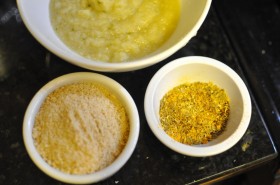

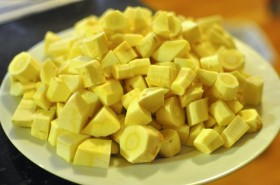

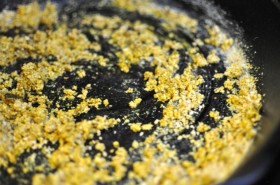
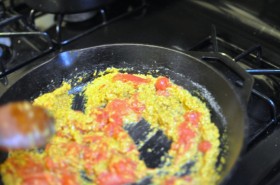
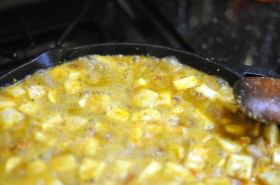
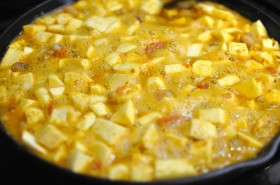
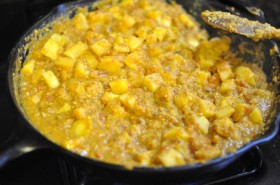
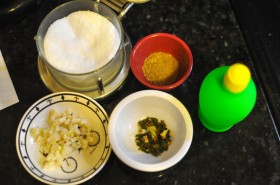

I’m intrigued by this recipe. Though my love of curries doesn’t extend to parsnips, this might be just the thing to enable me to happily consume the parsnips stored from last season…
And, as always, beautiful execution and documentation!